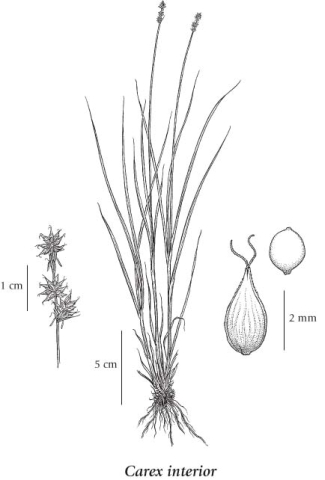Carex interior L.H. Bailey
inland sedge
Cyperaceae (Sedge family)
Introduction to Vascular Plants
inland sedge
Cyperaceae (Sedge family)
Introduction to Vascular Plants
Species Information
General:
Perennial, densely tufted herb from fibrous roots; stems 15-50 cm tall, usually longer than the leaves, roughened above on the angles.
Leaves:
Sheaths tight; blades about 3 per stem, flat or slightly channeled, borne on lower 1/2 of the stem, 1-3 mm wide, the lower ones reduced.
Flowers:
Spikes 2 to 6, the terminal one 0.4-0.7 mm long, with both male and female flowers, the female flowers towards the tips (sometimes almost all male and linear or almost all female and cylindrical), the lower spikes 1 to 5, ascending to widely spreading, remote to crowded, (1) 5- to 10-flowered, with female flowers only, unstalked; bracts inconspicuous, scalelike.
Fruits:
Perigynia egg-shaped to deltoid, 2.2-3.2 mm long, 1.5-2 mm wide, widest towards the bases, plano-convex, spreading, ascending or appressed, greenish or pale brown, finely-nerved to nerveless, sharp and thick margined, spongy below, the beaks 1/3 to 1/4 the length of the bodies, inconspicuously bidentate; female scales broadly egg-shaped, rounded at the tips, shorter than the perigynia, yellowish-brown, with greenish midribs, the margins whitish and translucent; stigmas 2; achenes lens-shaped, 1.2-1.5 mm long.
Illustration

If more than one illustration is available for a species (e.g., separate illustrations were provided for two subspecies) then links to the separate images will be provided below. Note that individual subspecies or varietal illustrations are not always available.
Illustration Source: The Illustrated Flora of British Columbia
USDA Species Characteristics
Flower Colour:
Green
Blooming Period:
Mid Spring
Fruit/Seed characteristics:
Colour: Brown
Present from Spring to Summer
Source: The USDA
Ecology
Ecological Framework for Carex interior
The table below shows the species-specific information calculated from
original data (BEC database) provided by the BC Ministry of Forests and Range.
(Updated August, 2013)
The table below shows the species-specific information calculated from
original data (BEC database) provided by the BC Ministry of Forests and Range.
(Updated August, 2013)
| Site Information |
Value / Class |
||
|
Avg |
Min |
Max |
|
| Elevation
(metres) |
934 | 5 | 1969 |
| Slope
Gradient (%) |
3 | 0 | 120 |
|
Aspect (degrees) |
155 | 5 | 354 |
| Soil
Moisture Regime (SMR) [0 - very xeric; 4 - mesic; 8 - hydric] |
6 | 0 | 8 |
| Modal
Nutrient Regime
Class |
D | ||
| #
of field plots species was recorded in: |
185 | ||
| Modal
BEC Zone Class |
SBS | ||
|
All BEC Zones (# of stations/zone) species was recorded in |
BAFA(1), BWBS(19), CDF(3), CWH(11), ESSF(20), ICH(39), IDF(11), MS(13), SBPS(10), SBS(46), SWB(1) | ||
|
Source:
Klinkenberg 2013
|
|||
Habitat and Range
Bogs, fens, swamps and wet meadows in the lowland, steppe and montane zones; frequent E of the Coast-Cascade Mountains, infrequent in SW BC; N to AK, YT and NT, E to NF and S to ME, PA, VA, GA, AR, KS, NM, AZ and CA.Status Information
Synonyms
Synonyms and Alternate Names:
Carex interior subsp. charlestonensis Clokey
Carex interior var. keweenawensis F.J. Herm.